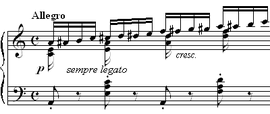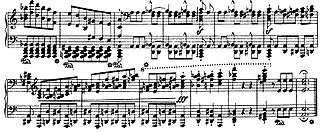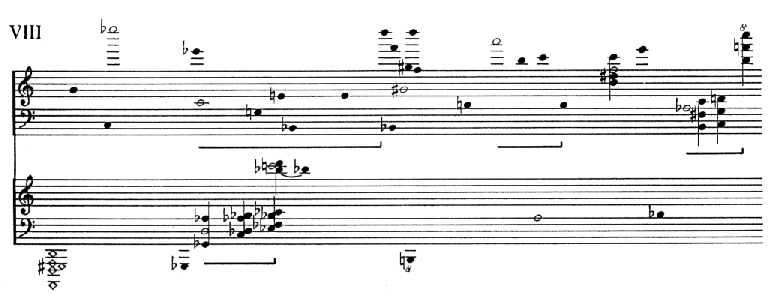
Étude
Encyclopedia

An étude is an instrumental musical composition
Musical composition
Musical composition can refer to an original piece of music, the structure of a musical piece, or the process of creating a new piece of music. People who practice composition are called composers.- Musical compositions :...
, most commonly of considerable difficulty, usually designed to provide practice material for perfecting a particular technical skill. The tradition of writing études emerged in the early 19th century with the rapidly growing popularity of the piano
Piano
The piano is a musical instrument played by means of a keyboard. It is one of the most popular instruments in the world. Widely used in classical and jazz music for solo performances, ensemble use, chamber music and accompaniment, the piano is also very popular as an aid to composing and rehearsal...
. Of the vast number of études from that era some are still used as teaching material (particularly pieces by Carl Czerny
Carl Czerny
Carl Czerny was an Austrian pianist, composer and teacher. He is best remembered today for his books of études for the piano. Czerny's music was profoundly influenced by his teachers, Muzio Clementi, Johann Nepomuk Hummel, Antonio Salieri and Ludwig van Beethoven.-Early life:Carl Czerny was born...
and Muzio Clementi
Muzio Clementi
Muzio Clementi was a celebrated composer, pianist, pedagogue, conductor, music publisher, editor, and piano manufacturer. Born in Italy, he spent most of his life in England. He is best known for his piano sonatas, and his collection of piano studies, Gradus ad Parnassum...
), and a few, by major composers such as Frédéric Chopin
Frédéric Chopin
Frédéric François Chopin was a Polish composer and virtuoso pianist. He is considered one of the great masters of Romantic music and has been called "the poet of the piano"....
, Franz Liszt
Franz Liszt
Franz Liszt ; ), was a 19th-century Hungarian composer, pianist, conductor, and teacher.Liszt became renowned in Europe during the nineteenth century for his virtuosic skill as a pianist. He was said by his contemporaries to have been the most technically advanced pianist of his age...
, Claude Debussy
Claude Debussy
Claude-Achille Debussy was a French composer. Along with Maurice Ravel, he was one of the most prominent figures working within the field of impressionist music, though he himself intensely disliked the term when applied to his compositions...
and Charles-Valentin Alkan
Charles-Valentin Alkan
Charles-Valentin Alkan was a French composer and one of the greatest virtuoso pianists of his day. His attachment to his Jewish origins is displayed both in his life and his work. He entered the Paris Conservatoire at the age of six, earning many awards, and as an adult became a famous virtuoso...
, achieved a place in today's concert repertory. Composers of the 20th century variously composed études related to the old tradition (György Ligeti
György Ligeti
György Sándor Ligeti was a composer of contemporary classical music. Born in a Hungarian Jewish family in Transylvania, Romania, he briefly lived in Hungary before becoming an Austrian citizen.-Early life:...
), études that required wholly unorthodox technique (John Cage
John Cage
John Milton Cage Jr. was an American composer, music theorist, writer, philosopher and artist. A pioneer of indeterminacy in music, electroacoustic music, and non-standard use of musical instruments, Cage was one of the leading figures of the post-war avant-garde...
), and études that required unusually facile technique.
19th century
Studies, "lessons" and other didactic instrumental pieces composed before the 19th century are very varied, without any established genres. The pieces in luteLute
Lute can refer generally to any plucked string instrument with a neck and a deep round back, or more specifically to an instrument from the family of European lutes....
instruction books, such as the celebrated Varietie of Lute-Lessons (1610), may be arranged in order of increasing difficulty, but will usually include both simple teaching pieces and masterworks by renowned composers. Domenico Scarlatti
Domenico Scarlatti
Giuseppe Domenico Scarlatti was an Italian composer who spent much of his life in the service of the Portuguese and Spanish royal families. He is classified as a Baroque composer chronologically, although his music was influential in the development of the Classical style...
's 30 Essercizi per gravicembalo ("30 Exercises for harpsichord", 1738) do not differ in scope from his other keyboard works, and Johann Sebastian Bach
Johann Sebastian Bach
Johann Sebastian Bach was a German composer, organist, harpsichordist, violist, and violinist whose sacred and secular works for choir, orchestra, and solo instruments drew together the strands of the Baroque period and brought it to its ultimate maturity...
's four volumes of Clavier-Übung ("keyboard practice") contain everything from simple organ duets to the extensive and difficult Goldberg Variations
Goldberg Variations
The Goldberg Variations, BWV 988, is a work for harpsichord by Johann Sebastian Bach, consisting of an aria and a set of 30 variations. First published in 1741, the work is considered to be one of the most important examples of variation form...
.
The situation changed in the early 19th century because of the growing popularity of the piano as a domestic instrument. Instruction books with exercises became very common. Of particular importance were collections of "studies" by Johann Baptist Cramer
Johann Baptist Cramer
Johann Baptist Cramer was an English musician of German origin. He was the son of Wilhelm Cramer, a famous London violinist and musical conductor, one of a numerous family who were identified with the progress of music during the 18th and 19th centuries.-Biography:Johann Baptist Cramer was born in...
(published between 1804 and 1810), early parts of Muzio Clementi
Muzio Clementi
Muzio Clementi was a celebrated composer, pianist, pedagogue, conductor, music publisher, editor, and piano manufacturer. Born in Italy, he spent most of his life in England. He is best known for his piano sonatas, and his collection of piano studies, Gradus ad Parnassum...
's Gradus ad Parnassum (1817–26), numerous works by Carl Czerny
Carl Czerny
Carl Czerny was an Austrian pianist, composer and teacher. He is best remembered today for his books of études for the piano. Czerny's music was profoundly influenced by his teachers, Muzio Clementi, Johann Nepomuk Hummel, Antonio Salieri and Ludwig van Beethoven.-Early life:Carl Czerny was born...
, and Ignaz Moscheles
Ignaz Moscheles
Ignaz Moscheles was a Bohemian composer and piano virtuoso, whose career after his early years was based initially in London, and later at Leipzig, where he succeeded his friend and sometime pupil Felix Mendelssohn as head of the Conservatoire.-Sources:Much of what we know about Moscheles's life...
' Studien Op. 70 (1825–26). Most of these pieces concentrated on the technical side of music and were not intended for performance. However, with the late parts of Clementi's collection and Moscheles' Charakteristische Studien Op. 95 (1836–37) the situation began to change, with both composers striving to create music that would both please the audiences in concert and serve as a good teaching tool. Such combination of didactic and musical value in a study is sometimes referred to as a concert study.

Études (Chopin)
The Études by Frédéric Chopin are three sets of solo studies for the piano, There are twenty-seven overall, comprising two separate collections of twelve, numbered Opus 10 and 25, and a set of three without opus number.-Composition:...
, Op. 10 (1833) and Op. 25 (1837) were the first to retain a firm position in the concert repertory, and are commonly regarded today as some of the finest études ever written. The technique required to play them was extremely novel at the time of their publication, and the first performer who succeeded at mastering these pieces was the renowned virtuoso composer, Franz Liszt
Franz Liszt
Franz Liszt ; ), was a 19th-century Hungarian composer, pianist, conductor, and teacher.Liszt became renowned in Europe during the nineteenth century for his virtuosic skill as a pianist. He was said by his contemporaries to have been the most technically advanced pianist of his age...
(to whom Chopin's Op. 10 is dedicated). Liszt himself composed a number of études that were more extensive, and even more complex than Chopin's. Among these, the most well-known is the collection Études d'Execution Transcendante
Transcendental Etudes
The Transcendental Etudes , S.139, are a series of twelve compositions for solo piano by Franz Liszt. They were published in 1852 as a revision of a more technically difficult 1837 series, which in turn were the elaboration of a set of studies written in 1826:...
(final version published in 1852). These did not retain the didactic aspect of Chopin's work, however, since the difficulty (and the technique used) varies within a given piece. Collections of études by Charles-Valentin Alkan
Charles-Valentin Alkan
Charles-Valentin Alkan was a French composer and one of the greatest virtuoso pianists of his day. His attachment to his Jewish origins is displayed both in his life and his work. He entered the Paris Conservatoire at the age of six, earning many awards, and as an adult became a famous virtuoso...
, marked by harmonic and structural experimentation, are similar in this aspect. Alkan's work includes some of the first études written for a single hand.
The 19th century also saw a number of étude and study collections for instruments other than the piano. Violin études by Rodolphe Kreutzer
Rodolphe Kreutzer
Rodolphe Kreutzer was a German violinist, teacher, conductor, and composer of forty French operas.-Biography:...
, Federigo Fiorillo and others, and cello études by Friedrich Dotzauer and Friedrich Wilhelm Grutzmacher are used mostly as teaching tools today. The only études to make their way to concert repertory are those by Niccolò Paganini
Niccolò Paganini
Niccolò Paganini was an Italian violinist, violist, guitarist, and composer. He was one of the most celebrated violin virtuosi of his time, and left his mark as one of the pillars of modern violin technique...
: 24 Caprices
24 Caprices for Solo Violin (Paganini)
The 24 Caprices for Solo Violin, Op. 1 was written by Niccolò Paganini between 1802 and 1817 and published in 1819. They are also designated as M.S. 25 in Maria Rosa Moretti and Anna Sorrento's Catalogo tematico delle musiche di Niccolò Paganini, which was published in 1982...
(1802–17). These works all conform to the standard definition of 19th century étude in that they are short compositions, each exploiting a single facet of technique. Collections of studies for flute were published during the second half of the 19th century by Ernesto Köhler
Ernesto Köhler
Ernesto Köhler was a flautist and composer. He was taught the flute by his father, Venceslau Joseph Köhler, who was the first flute of the Duke of Modena's orchestra....
, Wilhelm Popp and Adolf Terschak.
20th century

Claude Debussy
Claude-Achille Debussy was a French composer. Along with Maurice Ravel, he was one of the most prominent figures working within the field of impressionist music, though he himself intensely disliked the term when applied to his compositions...
's Études
Études (Debussy)
Claude Debussy's Études are a set of 12 piano etudes composed in 1915. The pieces are extremely difficult to play, as Debussy himself admitted, describing them as "a warning to pianists not to take up the musical profession unless they have remarkable hands"...
for piano (1915) conform to the "one facet of technique per piece" rule, but exhibit unorthodox structures with many sharp contrasts, and many concentrate on sonorities and timbres peculiar to the piano, rather than technical points. Leopold Godowsky
Leopold Godowsky
Leopold Godowsky was a famed Polish American pianist, composer, and teacher. One of the most highly regarded performers of his time, he became known for his theories concerning the application of relaxed weight and economy of motion in piano playing, principles later propagated by Godowsky's...
's 53 Studies on the Chopin Études
Studies on Chopin's Etudes
The Studies on Chopin's Études, by Leopold Godowsky, is a set of 53 arrangements of Chopin's études. The Studies on Chopin's Études, by Leopold Godowsky, is a set of 53 arrangements of Chopin's études. The Studies on Chopin's Études, by Leopold Godowsky, is a set of 53 arrangements of Chopin's...
(1894–1914) are built on Chopin's études: Godowsky's additions and changes elevated Chopin's music to new, hitherto unknown levels of difficulty, which led Ferruccio Busoni
Ferruccio Busoni
Ferruccio Busoni was an Italian composer, pianist, editor, writer, piano and composition teacher, and conductor.-Biography:...
to remark that Godowsky was the only composer to have added anything of significance to keyboard writing since Liszt. Other important études of this period include Heitor Villa-Lobos
Heitor Villa-Lobos
Heitor Villa-Lobos was a Brazilian composer, described as "the single most significant creative figure in 20th-century Brazilian art music". Villa-Lobos has become the best-known and most significant Latin American composer to date. He wrote numerous orchestral, chamber, instrumental and vocal works...
' virtuoso 12 Études for guitar (1929) and pieces by Russian composers: Sergei Rachmaninoff
Sergei Rachmaninoff
Sergei Vasilievich Rachmaninoff was a Russian composer, pianist, and conductor. Rachmaninoff is widely considered one of the finest pianists of his day and, as a composer, one of the last great representatives of Romanticism in Russian classical music...
's Études-Tableaux (1911, 1917) and several collections by Alexander Scriabin
Alexander Scriabin
Alexander Nikolayevich Scriabin was a Russian composer and pianist who initially developed a lyrical and idiosyncratic tonal language inspired by the music of Frédéric Chopin. Quite independent of the innovations of Arnold Schoenberg, Scriabin developed an increasingly atonal musical system,...
(all for piano).
By mid-century the old étude tradition was largely abandoned. Olivier Messiaen
Olivier Messiaen
Olivier Messiaen was a French composer, organist and ornithologist, one of the major composers of the 20th century. His music is rhythmically complex ; harmonically and melodically it is based on modes of limited transposition, which he abstracted from his early compositions and improvisations...
's Quatre études de rythme ("Four studies in rhythm", 1949–50) were not didactic compositions, but experiments with serial
Serialism
In music, serialism is a method or technique of composition that uses a series of values to manipulate different musical elements. Serialism began primarily with Arnold Schoenberg's twelve-tone technique, though his contemporaries were also working to establish serialism as one example of...
durations
Note value
In music notation, a note value indicates the relative duration of a note, using the color or shape of the note head, the presence or absence of a stem, and the presence or absence of flags/beams/hooks/tails....
and pitches. John Cage
John Cage
John Milton Cage Jr. was an American composer, music theorist, writer, philosopher and artist. A pioneer of indeterminacy in music, electroacoustic music, and non-standard use of musical instruments, Cage was one of the leading figures of the post-war avant-garde...
's etudes—Études Australes
Etudes Australes
Etudes Australes is a set of etudes for piano solo by John Cage, composed in 1974–75 for Grete Sultan. It comprises 32 indeterminate pieces written using star charts as source material. The etudes, conceived as duets for two independent hands, are extremely difficult to play...
(1974–75) for piano, Études Boreales
Etudes Boreales
Etudes Boreales is a set of etudes for cello and/or piano composed by John Cage in 1978. The set is a small counterpart to Cage's other etude collections - Etudes Australes for piano and Freeman Etudes for violin....
(1978) for cello and/or piano and Freeman Études
Freeman Etudes
Freeman Etudes are a set of etudes for solo violin composed by John Cage. Like the earlier Etudes Australes for piano, these works are incredibly complex, nearly impossible to perform, and represented for Cage the "practicality of the impossible" as an answer to the notion that resolving the...
(1977–80, 1989–90) for violin—are indeterminate
Indeterminacy in music
Indeterminacy in music, which began early in the twentieth century in the music of Charles Ives, and was continued in the 1930s by Henry Cowell and carried on by his student, the experimental music composer John Cage beginning in 1951 , came to refer to the movement which grew up around Cage...
pieces based on star chart
Star chart
A star chart is a map of the night sky. Astronomers divide these into grids to use them more easily. They are used to identify and locate astronomical objects such as stars, constellations and galaxies. They have been used for human navigation since time immemorial...
s, and some of the most difficult works in the repertory. The three books of Études
Études (Ligeti)
The Hungarian composer György Ligeti composed a cycle of 18 Études for solo piano between 1985 and 2001. They are generally seen as one of the major creative achievements of his last decades, and one of the most significant sets of piano studies, combining virtuoso technical problems with...
by György Ligeti
György Ligeti
György Sándor Ligeti was a composer of contemporary classical music. Born in a Hungarian Jewish family in Transylvania, Romania, he briefly lived in Hungary before becoming an Austrian citizen.-Early life:...
(1985, 1988–94, 1995) are perhaps closest to the old tradition in that they too concentrate each on a particular technique.
21st century
Already in the 20th century composers used not only the keyboard but also the inner parts of the piano. Accordingly, new series of Etudes had been composed. An example are the cycle of etudes Postales submarinas (Etudes for Inside Piano) by Juan María SolareJuan María Solare
Juan María Solare is an Argentine composer and pianist.-Education:Born in Buenos Aires, Argentina, Solare studied and received his diploma in piano , composition and conducting at the Conservatorio Nacional de Música Carlos López Buchardo...
.
See also
- List of étude composers
- Melinda Morgans classic Novel Étude.

